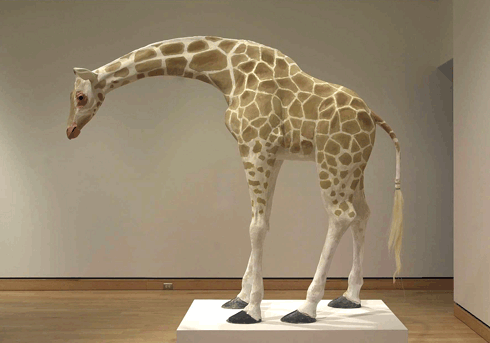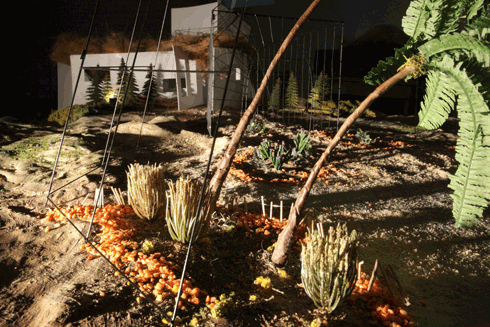Natural History
Curated by Jennifer Rudder
Inspired by the theatrical scope of the dioramas and monumental animal displays at the American Museum of Natural History (AMNH) in New York City, NATURAL HISTORY presents works of contemporary art that focus on the captivity and display of animals and humans. Artworks in the exhibition focus on the representation of animals and humans and the connection to empire, national identity and concepts of evolution. The artists revisit the relationship between humans and animals from the colonial past to the present through the history of collecting, the development of museums and zoos and the anthropological display of humans.
After the publication of Charles Darwin’s On the Origin of Species, the theories of evolution and polygenesis were still hotly debated, with many scientists unconvinced. The museological display of people was constructed as proof of arrested development in non-Western peoples, on the one hand, and of the progress of Western civilizations on the other. Crystal Mowry’s installation offers an oblique lesson of the short, tragic history of the display of humans. Behind a glass window a dimly lit diorama gives onto an open room behind. In a sparse desolate landscape of palm trees and brush, sit three miniature architectural elements. Behind the viewer a live video feed provides a steady and unchanging view of the diorama in grainy black and white. As encountered in many a frustrating trip to the zoo, the animals are sleeping.
Twilight of an Empire refers to the anthropological display of Ota Benga, a Congolese Pygmy brought to America to the 1904 St. Louis Purchase Universal Exhibition. After the exhibition, Ota Benga was brought to the New York Zoo in the Bronx where his brief captivity in the monkey house created fierce racial debates. The miniature format of Twilight of an Empire evokes aspects of ownership, dominion and the colonizing impulse that are all present in the historical moment depicted. Between the diorama and the video stream, Mowry creates room for uncertainty, situating the viewer somewhere between the lived event and a document.

As the scientific expansion of the nineteenth century proceeded, the natural world still seemed inexhaustible, and its exploitation was blessed by the religious beliefs and prevailing philosophies of the age. Trevor Gould’s work enters into the critique of colonialism and national identity through his sculpture, painting and installations of wild animals from his native South Africa. His Model of a Nubian Giraffe after Jacques-Laurent Agasse, 1827, is a ¾ scale sculpture of a giraffe based on the painting by the Swiss artist Agasse. The painting speaks volumes of the nineteenth century fixation on the exoticism of African animals and their subsequent collection in menageries of royalty and the wealthy.
In Trevor Gould’s sculpture the colonial perspective of Africa is re-interpreted through reference to the innovative taxidermy methods of Carl Akeley the hunter, curator and taxidermist/sculptor of the American Museum of Natural History. Much of Gould’s work has as its subject the complex cultural practices of display. Implicit in the presentation dioramas of the American Museum of Natural History is a calculated assumption of humanity’s separation from (and implied superiority) over the natural world of mammals, creating an ‘us and them’ dichotomy.
In Joshua Jensen-Nagle’s large scale photograph More Than You and Me, a standing polar bear comes forward out of the darkness like a ghost. It is one of a series of photographs taken of taxidermy animals in the Hall of the North American Mammals at the American Museum of Natural History. The photograph was made by using expired Polaroid film and a soft focus lens, and then sealed in a coat of polymer resin. Like a doomed Victorian specimen preserved in amber, the thick shiny coating of More Than You and Me captures one of the world’s largest beasts at a time when the species is threatened by extinction. Imbued with a glowing blurriness, the photograph lends an impossible romanticism to the polar bear’s plight.

The Polaroid camera was famous in the pre-digital years for providing an “instant’ photograph, yet the many layers of artifice in Jensen-Nagle’s laborious process echoes the time involved in the making of the display – the hunt and capture of the animal, the involved process of sculpting, taxidermy and the creation of the diorama. Just as the taxidermy re-presentation of the dead polar bear makes it appear live; the artifice of the photograph More Than You and Me makes the inanimate bear come to life. The photograph is as deceptive as the dioramas of the AMNH.
By the late 1800s the public zoological park was a flourishing concept and a worldwide reality. Zoos strove to exhibit a comprehensive range of species arranged in solitary displays of representatives caged in isolation as a kind of dictionary or living library of nature. In the early 1900s ‘bar-less’ enclosures surrounded by moats heralded a revolutionary leap forward in zoo design.
The photographs of Volker Seding’s “The Zoo Portfolio” serve as documentation of the tragedy that was the early zoo. Together the images of his project, such as Black Rhinoceros, Brookfield Zoo, Chicago, 1985, speak of the abjection to which the large mammals have been relegated. The dejected rhinoceros stands facing the camera in a small cement cage. Large rock formations limit its space even further. The most disturbing aspect of the photograph are the walls that surround the rhino have been painted with a brightly coloured mural of trompe l’oeil scenery, meant to recreate the rhino’s natural habitat in Africa. While the taxidermy animals of the AMNH are always shown in family groupings, this rhino stands alone, a single exemplar of his species.

In the video Deeparture, artist Mircea Cantor confined a deer and a wolf in the unlikely environment of a white cube gallery and filmed the result. In a series of taut close-ups from various angles, the looping video is a poetic reflection on alienation and captivity that confounds expectations. The expected “natural” predator-prey relationship does not play itself out here. The situation in the pristine gallery is far from natural and elicits an unnatural response. The instinctive behaviour of apprehension, fear and alienation are all present within the silent surveillance of the camera. As climate change forces animals to move further south and the built environment encroaches further into the wild, Cantor’s film offers the possibility of either a truce between civilization and the wild, or a future of animals tamed by our structures, caged within our cities in urban zoos.
Each artwork in NATURAL HISTORY evokes a moment in the complex history of the captivity, collection and display of wild animals and indigenous people. Trevor Gould and Joshua Jensen-Nagle find their way into that history of the colonial pillage of animals through the work and practice of other artists and curators such as J. L. Agasse and Carl Akeley. Crystal Mowry’s critical examination of one life implicated in the vicious racism at the base of the anthropological display is crucial to our understanding of that past. Mircea Cantor’s video confronts us with the separation over time of human from mammal and gives us the possibility of imagining a renewed co-existence. Volker Seding’s rigorous documentation haunts the exhibition with the abjection that was until recently, the zoo. As the built environment spreads into land formerly inhabited by wildlife, and as changing weather patterns force wild animals into our midst in suburb and city what is the future of the animal? It is to be hoped that with the advent of high definition television, quality nature programming and the availability of cameras, that the captivity of wild animals for displays in zoos or hunting animals for museum dioramas is over.
|


